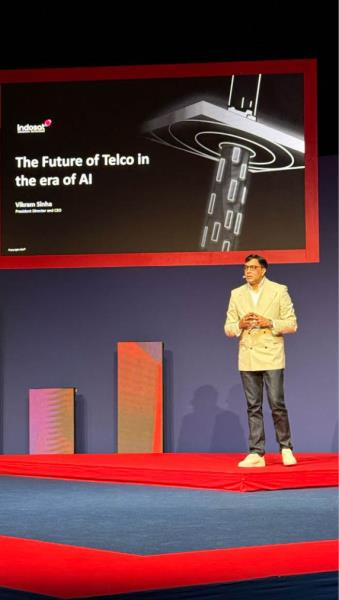02 July 2024

Vikram Sinha, president director and chief executive officer, Indosat Ooredoo Hutchison
When we started our journey in the merger to form Indosat Ooredoo Hutchison some 28 months ago, we agreed that it would be good for our customers, good for our country, and good for our employees. Today, the numbers speak for themselves. Coverage is up, consistency and experience are improved, and we truly have benefited Indonesia as a whole.
It’s become clear in a post-COVID world that the telecommunications sector plays a vital role in the digital economy and has a significant impact on GDP growth. In the last two years, the industry has been growing at 5%, but I believe it has the potential to expand by 8-10%.
AI is democratising innovation at a phenomenal pace. Back in 2008, Apple launched their Apple Store with just 500 applications, and in 2012, Google did the same, but with 16,000. ChatGPT, meanwhile, launched last year with 3 million – imagine the democratisation and innovation to come in the next few years!
We believe that AI is linked to our larger purpose of empowering every Indonesian and has the potential to help GDP grow faster.
Growth mindset
Looking to the future and our goals, we have built ourselves on three pillars.
The first pillar is becoming an AI-native telco. Embedding AI in our core business starts with virtualisation around customer offerings, managing our CapEx and productivity, into procurement, HR, sales and marketing – every business function. The second pillar is to become an AI-native techco, which talks about creating new businesses; our focus will be content like sovereign cloud security, and we are focusing on verticals like financial institutions and energy companies. The third pillar is in creating an AI nation shaper; we are working on our AI Centre of Excellence and are also putting disproportionate focus on human capital development. Technology without investment is destined to fail. If we don’t invest in human capital, how can we create skills?
When we talk about moving from telco to techco, this reflects the market and the new business opportunities we’re seeing. Today, banks are approaching us for help with sovereign cloud and sovereign infrastructure – the focus is not on connectivity anymore. They want to know how we can help solve money laundering or Know Your Customer (KYC) problems.
And it’s not just urban centres and big city users - one of the things which is often underestimated is how even the most rural of communities are adapting to technology. Farmers in Indonesia are using AI to increase their crop yields, for example, despite their many years of knowledge. For the country to advance, it must use technology as an enabler, and democratise not only on tier one and tier two, but also on the most rural.
With our growth mindset, we want to double our EBITDA to $3 billion by 2028. There is so much opportunity in Indonesia - 21 million new customers coming from rural regions are first time internet users. There are very few countries in the world like it, and with growing ARPU and GDP spend, whichever way you look at it, GB per user is under indexed.
There’s a clear opportunity to enhance ARPU from its current $2.8 to $4-5. By offering our customers data and connectivity, we’re helping people achieve productive work at a fraction of a cost. Delivering a ‘marvellous experience’ is one of our priorities, and rationalising our prices to remain sustainable is part of that.
FTTH home broadband is another growth engine in Indonesia. Only 15% of homes today are connected, but there are 80 million homes in the country. FTTH home broadband connectivity will expand to 30-35% in the next 3-4 years.
Each year, we spend some $700 million. Part of planning for the future and evolving from telco to AI-native techco is to talk about how we’re personalising things, how we’re managing CapEx in a more productive manner. Our CapEx intensity today is close to 24% of revenue, but going forwards, we’re not looking to save money – we’re in a growth mindset. We want to spend the same and make it more productive; and AI is going to help us in that.
Intelligent networks
Everyone is so excited about AI, but first, we must establish the horizontal platform. If you don’t get the basic steps right, you will not be able to scale things up. It took us a year to do with our partners, but we’re there now with our unified data platform on Google Cloud. On top of that horizontal platform, we must also have vertical expertise.
Incorporating AI into the network helps us bring our operating maturity level up a notch. To do this, we must understand our ecosystem in totality, so that we can exponentially grow our customer base.
When you look at AI, you start with efficiency and productivity, but you don’t stop there if you really want to unlock the full potential of AI. It is so important to look at growth. Growth will only happen when the leadership teams spend time on growth. In our case, we grew our revenues by 15% year-on-year last quarter, but EBITDA was up just 1% - this shows just how big an impact AI is having on driving core growth via ARPU increase.
We are seeing new opportunities that never existed before AI cloud, and things are moving very fast. We must be there when opportunity knocks.
One of the first successes which we saw was on our capacity planning – if our capacity is over places where nobody is using it, it’s not generating revenue.
Previously, this planning was done manually, and we’d achieve 75-80% accuracy. With AI, we have gotten close to 98%. We spend $300-400 million on capacity, so using AI for planning in the first quarter has saved us almost $10 million.
Another success where AI has really helped us is home broadband. Today, we’ve changed our approach to a building-by-building case; our platform analyses socioeconomic data, and we deliver FTTH accordingly. With this application, we’ve increased uptake from 13-14% to 15-16% in just six months.
Harmonising collaboration
Ensure effective collaboration and harmony among the various level partners in our ecosystem and considering potential conflicts that may arise is complex.
In my ecosystem, I have 960 vendors - out of that we have classified 66 as partners, of whom 22 are strategic partners. There is a clear difference between vendor, partner, and strategic partner. First, we must align the culture within the organisation – I don’t call my partners ‘vendors,’ I call them partner or strategic partner. It’s more than just a name; it’s an operating model that starts with me and my team, how we behave, how we talk, and how we operate.
There are difficult times of course, when you work with sovereign cloud. When working with a partner, sometimes there are conflicting messages, and the only solution is to be more open and transparent.
What I ask of the big tech companies is that they align their values first. Our actions must be good for our country, and fair for the partners on the ground, including us. Previously, there has been a trend where the big tech companies will say: “no, this cannot be done.” It’s not an easy thing, and we must work on a case-by-case basis to ensure our principles are aligned. We want to make money with our partner, not from our partner.
History shows us that telcos like us have been very inward looking. We used to complain about OTT operators to the regulator, but the reality was, the issues were more self-inflicted. We were not building trust with our customer, and we were not open.
For me personally COVID-19 was a pivot moment for the ecosystem - but AI is a much bigger pivot moment. Today, we must bring that learning mindset, let go of old ideas, and embrace the new.










